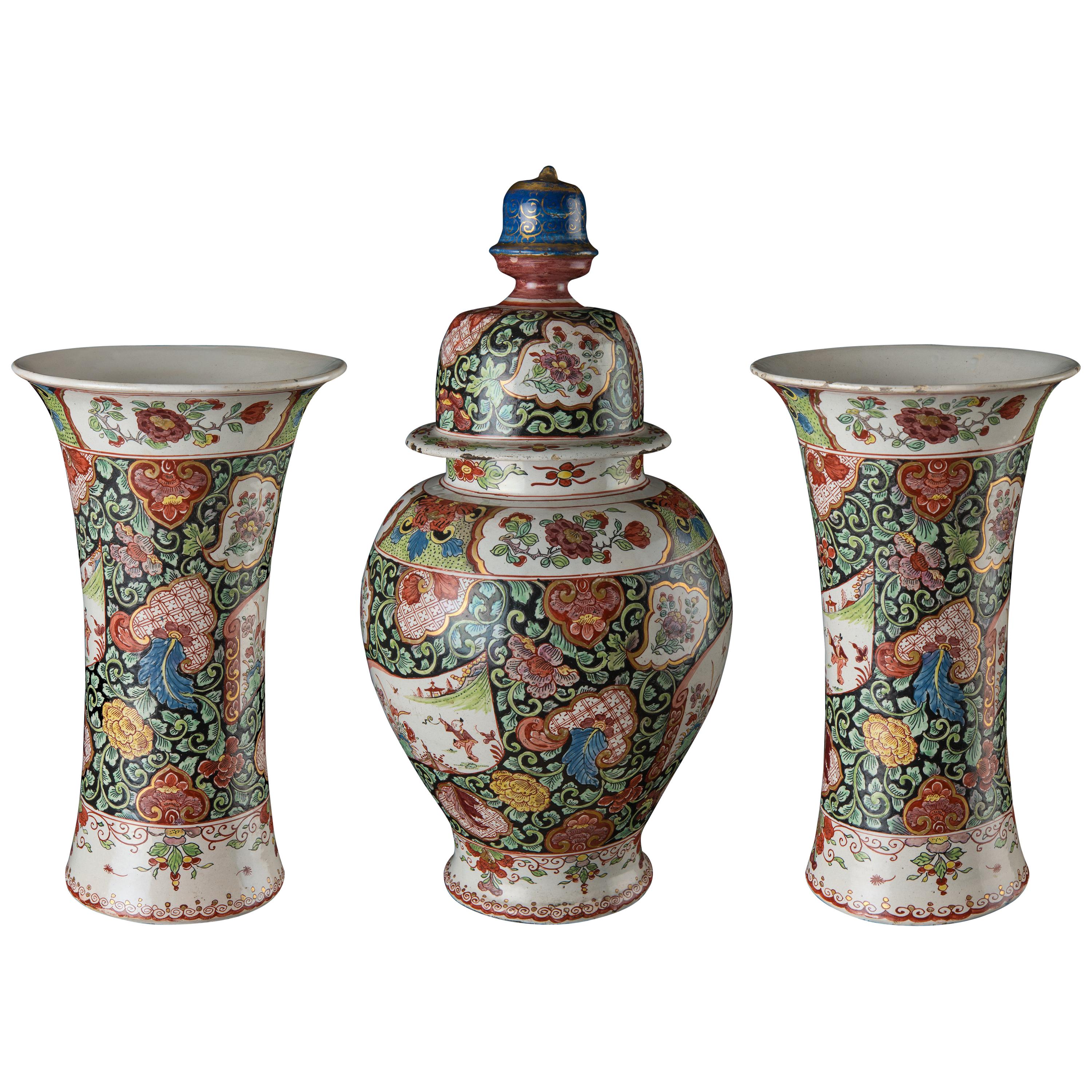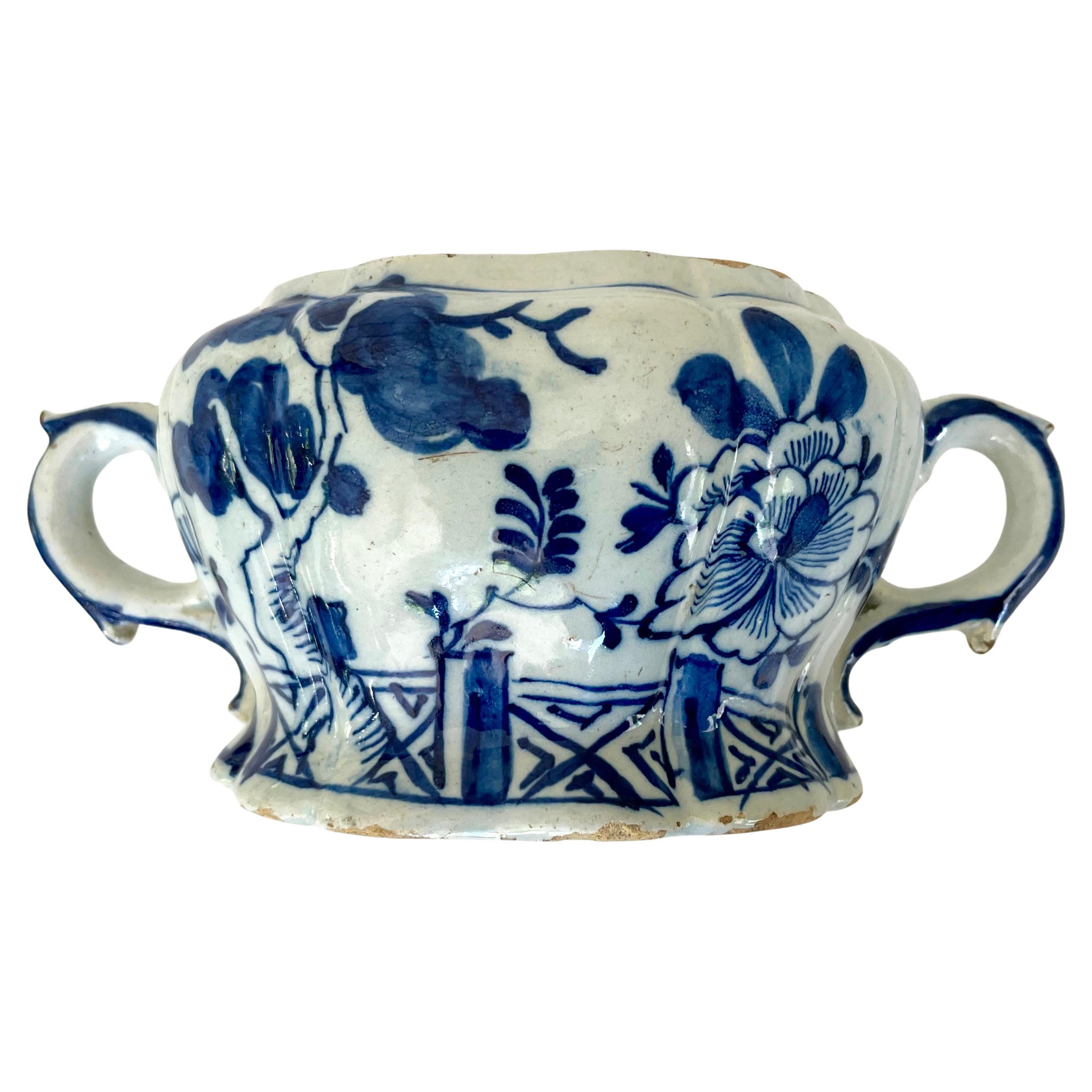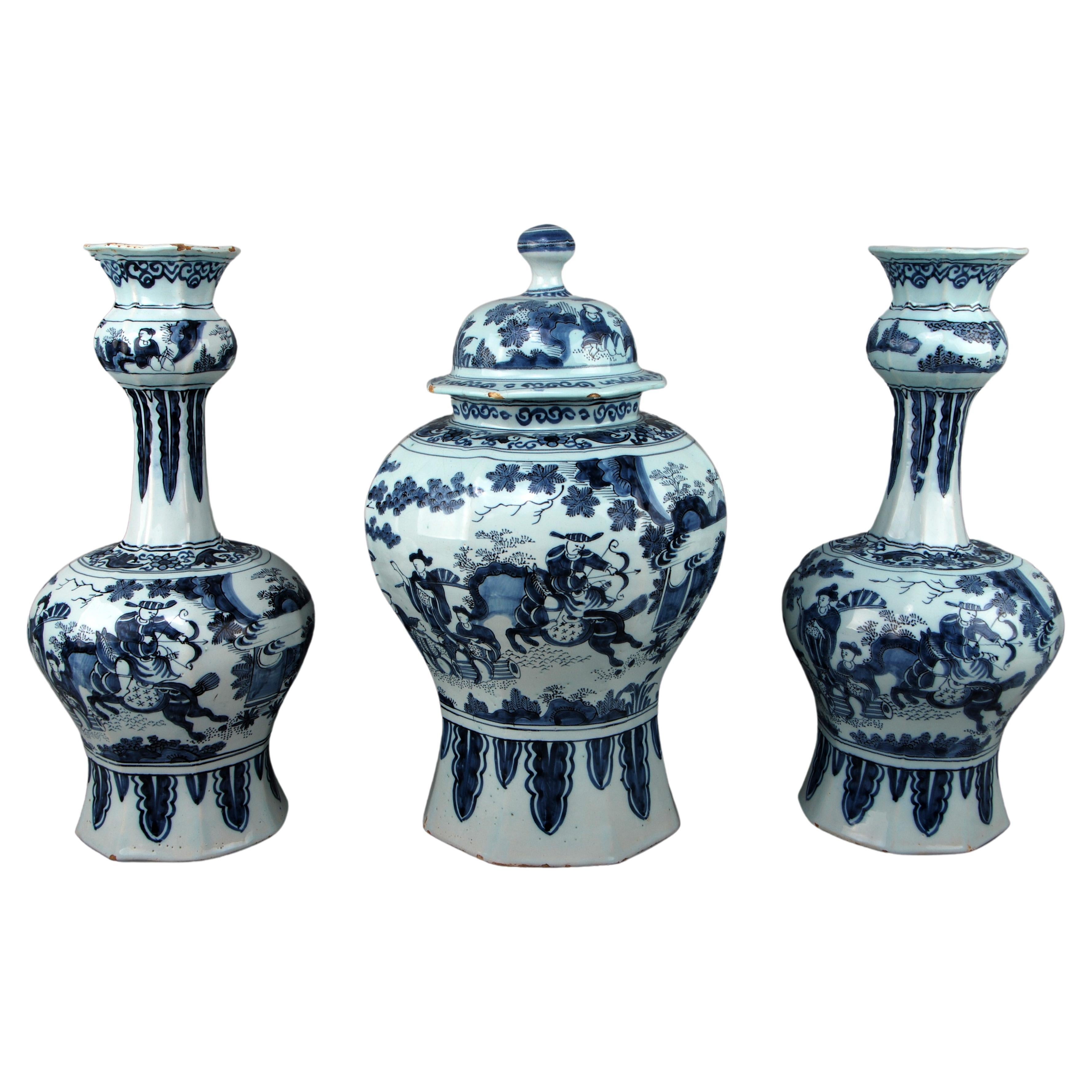Items Similar to Delft, Purple and Yellow Chinoiserie Jug, circa 1680-1700
Video Loading
Want more images or videos?
Request additional images or videos from the seller
1 of 9
Delft, Purple and Yellow Chinoiserie Jug, circa 1680-1700
About the Item
Purple and yellow chinoiserie jug. Delft, circa 1680 - 1700
The ovoid jug stands on a lightly spreading foot and has a tapered neck with spout. The top of the handle is pierced for a metal mount. The jug is painted in purple and yellow with a continuous chinoiserie landscape with Chinese figures. Bands with rectangular ornaments between double circles are applied on the shoulder and just above the foot. The neck is painted with a double leaf motif. The handle is decorated with stripes and dots, alternately applied in purlple and yellow.
Purple or multi-coloured Delftware with chinoiserie landscapes are relatively rare, though versions in blue and purple, blue and yellow, green and purple are known, as well as three colour combinations like purple, yellow and green. A butter pot in this last colour combination was excavated from a cesspit in the grounds of the former Porcelain Bottle pottery in Delft. Multi-coloured chinoiserie decorations are painted especially on lobed dishes and also on beer mugs, covered spiced wine bowls and small plates. A purple, yellow and green painted beer mug in the Princessehof Ceramics Museum in Leeuwarden, The Netherlands, combines a chinoiserie landscape with a depiction of stadtholder prins Willem III, the later King William of England (Jongstra, p. 19).
Chinese figures in a landscape are frequently painted on blue and white Delftware like jugs, vases and pots. Together with imitations of kraak porcelain, chinoiserie landscapes were the most popular decorations on Dutch delftware in the second half of the seventeenth century. They are based on Chinese porcelain from the period of the last Ming emperor Chongzhen (1628-1644). It is not clear if the Delftware potters followed Chinese porcelain. It is also possible that Japanese porcelain from the sixteen-fifties and sixties served as an example. The stylistic similarities between Delftware and Japanese porcelain are striking.
Dimensions: height 34 cm / 13.38 in, greatest diameter 19 cm / 7.18 in.
The Jug is about 330 years old and in good condition. One side of the spout is restored, retouched glaze loss to the inner upper side of the handle, usual rim chips.
I carefully package all items in a double-box and use first class packaging material.
- Creator:Dutch Originals (Maker)
- Dimensions:Height: 13.38 in (33.99 cm)Diameter: 7.48 in (19 cm)
- Style:Baroque (Of the Period)
- Materials and Techniques:
- Place of Origin:
- Period:Late 17th Century
- Date of Manufacture:1680-1700
- Condition:Repaired: One side of the spout is restored, retouched glaze loss to the inner upper side of the handle, usual rim chips. Wear consistent with age and use. Minor losses. The Jug is about 330 years old and in good condition.
- Seller Location:Verviers, BE
- Reference Number:1stDibs: LU1441223992692
About the Seller
4.9
Gold Seller
These expertly vetted sellers are highly rated and consistently exceed customer expectations.
Established in 2000
1stDibs seller since 2015
693 sales on 1stDibs
Typical response time: 2 hours
- ShippingRetrieving quote...Ships From: Velddriel, Netherlands
- Return PolicyA return for this item may be initiated within 3 days of delivery.
More From This SellerView All
- Purple and Yellow Chinoiserie Wine Jug, Delft, circa 1680By DelftLocated in Verviers, BEPurple and yellow chinoiserie wine jug. Delft, circa 1680 The ovoid wine jug stands on a low spreading foot, has a conical neck with spout and a pewter mount and cover. The ear-shaped handle has a rat tail finish. The jug is painted in purple and yellow with a continuous chinoiserie landscape with three Chinese figures. A band with scroll ornaments is applied to the shoulder just below the neck, the neck itself is decorated with two types of stylized leaves. Another band with block ornaments is painted above the foot. The handle is decorated with stripes, dots and scroll ornaments. Dimensions: height 22 cm / 8.66 in. Multi-coloured chinoiserie landscapes on Delftware were only made for a short period of time, roughly between about 1680 and 1690. Most of the decors have been applied on dishes, lobed dishes, butter pots...Category
Antique Late 17th Century Dutch Baroque Ceramics
MaterialsCeramic
- Delft, Blue and White floral Chinoiserie Jar, 1650-1680By Dutch OriginalsLocated in Verviers, BEThe ovoid jar stands on a slightly spreading foot, has a short upright neck, and is painted in blue with a floral decor. Three large cartouches containing flower bouquets have been a...Category
Antique 17th Century Dutch Baroque Delft and Faience
MaterialsCeramic, Faience
- Delft, Pair of Blue and White Chinoiserie Dishes, 1680 - 1700By Dutch OriginalsLocated in Verviers, BEPair of blue and white chinoiserie dishes. Delft 1680-1700. [attributed to] The Three Porcelain Ash Barrels pottery Pair of blue and white dishes with a wide-spreading flange, t...Category
Antique Late 17th Century Dutch Baroque Delft and Faience
MaterialsCeramic, Faience
- Polychrome Chinoiserie Wine Jug, Delft, circa 1680By DelftLocated in Verviers, BEThe polychrome wine jug has an ovoid body on a low spreading foot, a conical neck with spout and a handle with a scroll finish. The jug is painted in purple, yellow and green with a continuous chinoiserie landscape with three Chinese figures. A band with scroll ornaments and circles is applied to the shoulder just below the neck, the neck itself is decorated with two stylized flowers and scroll ornaments. The handle is decorated with stripes and scroll ornaments. Dimensions: height 19 cm / 7.48 in. Multi-coloured chinoiserie landscapes on Delftware were only made for a short period of time, roughly between about 1680 and 1690. Most of the decors have been applied on dishes, lobed dishes, butter pots...Category
Antique Late 17th Century Dutch Baroque Ceramics
MaterialsCeramic
- Delft, Blue and White Chinoiserie Altar Vase, circa 1685By Dutch OriginalsLocated in Verviers, BEBlue and white chinoiserie altar vase. Delft, circa 1685 The ovoid altar vase stands on a high-waisted foot. The flaring cylindrical neck ends in an outward sloping mouth rim. The two blue coloured lion-shaped handles have suspending rings in their jaws. The body is painted with a continuous oriental landscape with banana and pine trees, Chinese figures and houses, while the neck is painted with three bands of different ornaments. The mouth rim is decorated with rectangular ornaments, the foot with leaves under a band around the ankle. Altar vases are also called vases à chimères. The oldest faience examples were made in the sixteen-twenties in Nevers, France and are attributed to the Conrade potters family, who originated from Italy. The shape is based on metal vases used during the services in Catholic churches. Therefore it is no wonder that many altar vases are painted with the Christogram IHS. Altar vases were made in Delft from about 1675 onwards and production continued well into the eighteenth century. Marked examples are known from multiple manufacturers, such as The Greek A and The Moor’s Head potteries (Aronson 2011, pp. 14-15). A pair of eighteenth century vases was made between 1700 and 1716 at The Three Porcelain Ash Barrells pottery. They are marked with PK for the owner Pieter Kam or, after 1705, by his widow (Blazy & Boyazoglu 1983, p. 110). The pair is painted with a dense parsley decor. A miniature example was excavated from a cesspit in the grounds of the former Porcelain Bottle pottery in Delft. At the same location a larger fragment was also found, decorated with a triple-tulip design in blue and yellow (Eliëns, Schledorn, Van Aken-Fehmers, pp. 31 , 36, 45). Three altar vases with similar tulip and flower decoration in blue and yellow are in the collection of the Dutch Open Air Museum in Arnhem and can also be attributed to the Porcelain Bottle pottery (Klein, p. 152). Official Catholic services were not allowed in the seventeenth century in the Dutch republic, however Catholic conventicles were tolerated. At first sight it might be surprising that a Catholic object...Category
Antique Late 17th Century Dutch Baroque Delft and Faience
MaterialsCeramic, Faience
- Delft, Blue and White Beer Mug with Peacock in Garden, circa 1680-1700By Dutch OriginalsLocated in Verviers, BEBlue and white beer mug with peacock in garden. Delft, 1680-1700. The pear-shaped beer mug with pewter lid stands on a short foot and has an ear-shaped handle that ends in a rat t...Category
Antique Late 17th Century Dutch Baroque Delft and Faience
MaterialsCeramic, Faience
You May Also Like
- Blue and White Delft Handled Chinoiserie VaseBy DelftLocated in New York, NYBlue and white Delft handled chinoiserie vase. Antique Dutch porcelain vase with rich blue flowers and chinoiserie fencing in a lustrous glaze; with scro...Category
Antique Late 18th Century Dutch Chinoiserie Delft and Faience
MaterialsCeramic
- Royal Delft Garniture of 3 Vases Chinoiserie Beaker and Baluster Vases a pairBy AK Dutch Delftware, Delft, Royal DelftLocated in Wommelgem, VANA 3 pieces garniture of Dutch Delftware Royal Delft vases - Urns. Tall decorative covered baluster vases on an octagonal foot with 2 matching beaker vases The vases are hand crafted ...Category
20th Century Dutch Baroque Revival Delft and Faience
MaterialsEarthenware, Delft
- Important 17th Century Delft Chinoiserie Three Piece GarnitureLocated in AMSTERDAM, NHAn important 17th century Delft chinoiserie three-piece garniture The Netherlands, Delft. Last quarter of the 17th century An important and rare Delft garniture of three pieces. The shape and decoration are inspired on the Chinese Transitional porcelain...Category
Antique Late 17th Century Dutch Chinoiserie Delft and Faience
MaterialsFaience, Ceramic
- Blue and White Dutch Delft Lidded Jar in Chinoiserie, Early 18th CenturyBy DelftLocated in AMSTERDAM, NHAn Early Dutch Delftware lidded jar with chinoiserie decoration. Origine: Delft, The Netherlands Date: Early 18th century Workshop: Unknown. A genuine blue and white lidded j...Category
Antique Early 18th Century Dutch Chinoiserie Delft and Faience
MaterialsCeramic, Delft, Faience
- Blue and White Delft Mantle Jar Netherlands circa 1780Located in Katonah, NYThis charming blue and white Dutch Delft jar is decorated in shades of cobalt blue. Hand-painted in the late 18th century circa 1780, the jar mixes rococo and chinoiserie design elem...Category
Antique Late 18th Century Dutch Jars
MaterialsDelft
- Very Large Blue and White Dutch Delft Vase in Chinoiserie, Early 18th CenturyLocated in AMSTERDAM, NHA Rare and Very Large, Early Dutch Delftware vase with chinoiserie decoration. Origine: Delft, The Netherlands Date: 1724 - 1757 Workshop: De Metaale Pot under the management of Cornelis Koppens. Marked CK for Cornelis Koppens. The very large vase...Category
Antique Early 18th Century Dutch Chinoiserie Delft and Faience
MaterialsCeramic, Delft, Faience





